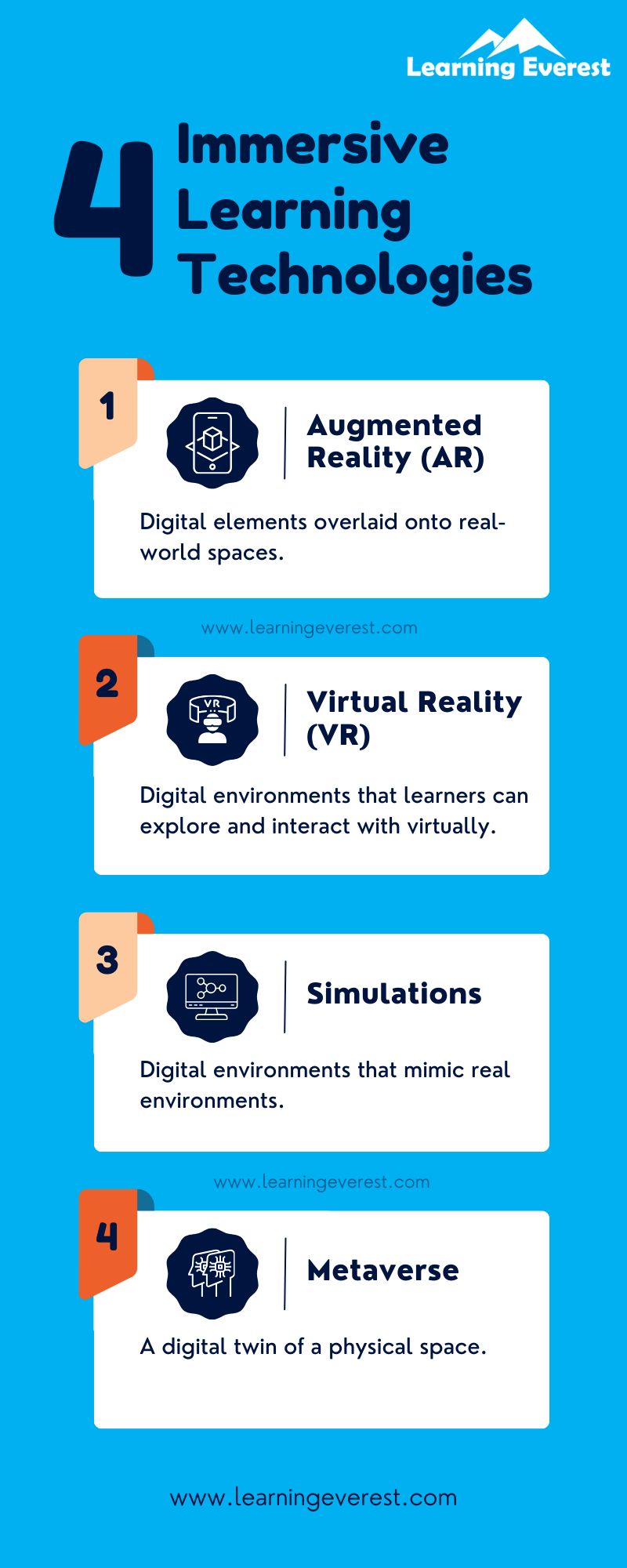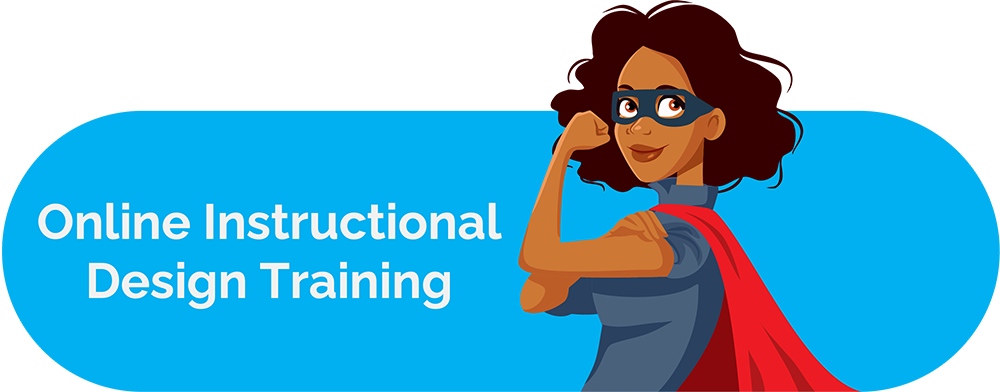Immersive learning technologies have been an emerging trend in eLearning due to their engaging, application-based training format that prepares learners for real-world scenarios. With advancements in immersive learning technologies, L&D departments now have more training delivery options. In this article, you will learn about immersive learning technologies and their uses, as well as the importance of immersive learning.
Table of Contents
What is Immersive Learning?
Immersive learning is learning that takes place in digital environments that mimic or reflect real-life environments. The situations and scenarios learners experience within these learning environments also reflect real-world situations.
Immersive learning makes learners active participants in the learning process by giving them opportunities to interact with the digital learning environment. Instead of being passive spectators, learners have agency and choice in the immersive learning environments and their actions influence outcomes in the learning journey.
As the name suggests, immersive learning is learning through immersion and is also referred to as “learning by doing.” Learners get to “be” in the learning environment, making the learning process more effective and engaging.
Through immersive learning, learners get a better sense of the actual working environments they will eventually become a part of. Thus, immersive learning helps build practical knowledge and skills and teaches learners to be better critical thinkers and problem solvers.
Overall, immersive learning is a highly engaging learning experience that can improve learners’ retention, attention, and knowledge acquisition, thereby increasing an intervention’s ROI and making learners more productive employees when the time comes.
Immersive Learning Technologies
Immersive learning technologies are technologies that add extra layers of interaction and involvement to a learning experience so as to transport learners into the learning environment.
They facilitate “learning by doing.” With immersive learning becoming an emerging trend in the training scene, immersive learning technologies are more relevant than ever before. Let us take a closer look at the different forms immersive learning might take.
Augmented Reality (AR)
In augmented reality, digital elements are overlaid onto real-world spaces. This can include buttons, menus, equipment, characters, text, etc. AR immersive learning requires specialized AR/VR gear.
Virtual Reality (VR)
VR immersive learning uses digital environments that learners can explore and interact with virtually. These environments mimic or replicate real-world spaces and are multidimensional. VR provides the highest level of immersion possible to learners by completely blocking out their external environment while they are in the immersive learning environment. This kind of learning also requires AR/VR equipment. In both, AR and VR immersive learning, learners interact with the digital environments using gestures or controllers.
Simulations
Simulations are also digital environments that mimic real environments, however, not all simulations use VR technology. Simulations can also be 2 dimensional and delivered through a PC, tablet, or mobile phone. Simulations provide learners with safe environments to practice important skills in. In simulations, learners can perfect important abilities, gain mastery over professional skills, and learn through their mistakes without the risk of real-world consequences for these mistakes. Hence, simulations are a safe and effective way to build proficiency in learners, making them job-ready with practical knowledge and skills.
Metaverse
A metaverse is a digital twin of a physical space. In other words, it perfectly replicates the physical space it is based on. A metaverse collects data from the physical environment it is based on and uses this data to further study this environment via the replica. Hence, a metaverse can be a powerful tool for running simulations to prepare learners for likely scenarios they might face on the field.
Immersive learning technologies are combined with existing eLearning approaches such as gamification, scenario-based learning, and personalized learning journeys to create meaningful learning experiences out of them. Let us now take a deep dive into immersive learning and its features.
Features of Immersive Learning
Immersive learning has some core features that remain similar across different learning programs. These are the elements that give immersive learning its edge.
Clear Objectives
Immersive learning experiences should have clear objectives, so learners know how to progress and navigate through the learning environment. Without clear objectives, learners might struggle to connect with the learning material since a large aspect of immersive courses is learning through experience.
Narrative-driven
Immersive learning requires a narrative to structure itself around. A narrative helps in building a meaningful learning journey that enables learners to meet learning and performance goals.
Interactive
Immersive learning has interactive elements like menus, controls, clickable items, etc. Immersive courses cannot be presented in a traditional text-heavy format. Instead, they should be presented using expandable tabs, short text, dialogues, gamification, etc.
Centered around the real world
Immersive learning aims to build knowledge and skills that can be applied in the real world. Hence, it presents content in a way that clearly emphasizes how it can/should be applied in the learners’ physical contexts. Immersive learning uses scenarios, hands-on activities, games, carefully constructed feedback, etc., to help learners draw a clear connection between information and its practical application.
Builds on learners’ intrinsic motivation
Instead of just using external motivators like scores, grades, certificates, promotions, etc., immersive learning taps into learners’ intrinsic motivation. It is novel and engaging format is enjoyable, sparks learners’ curiosity, and leverages their natural tendency for exploration and achievement. Immersive courses are deliberately made to be highly gripping. However, the medium is also inherently interesting and fun
Emotionally engages learners
Immersive learning also emotionally engages learners by making them active participants of the learning experience. The elements mentioned above, such as strong narratives, real-world relevance, interactive elements, and intrinsic motivation, all contribute to learners’ emotional engagement in immersive courses.
Advantages of Immersive Learning
Immersive learning is a leap in eLearning and is expanding the options learners and organizations have for accessing effective but non-traditional mediums of learning. Immersive learning can be a big investment, but it comes with a ton of benefits to back it up.
Experience-centred Learning
Immersive learning gives learners valuable experience for their actual working environments, building their confidence and familiarity with the expected eventual outcome of the learning experience.
Safe Learning Environments
Immersive learning environments allow learners to practice skills in a safe and risk-free environment. This ensures that the learner and business don’t face any real threats while trainees are still getting the hang of things.
Higher Learner Engagement
Immersive learning is a very engaging learning experience as it uses a variety of tools and techniques to make learners active participants in the learning process. Learners thus have an easier time connecting with the course. Immersive learning experiences are also more interesting than traditional learning experiences because they incorporate elements such as narratives, dialogues, exploration, gamification, etc.
Higher Learner Retention
Due to being more engaging and interesting, immersive learning also retains learners for a longer time. Higher learner retention means higher completion rates, reducing the likelihood of learners missing out on important information due to not completing a course.
Practical Learning
Lastly, immersive learning teaches learners practical skills and information that are relevant to their specific contexts, making learners more comfortable with the tasks they have to do.
Conclusion
Immersive learning is an excellent eLearning solution for providing learners with realistic, impactful, and actionable skills. They are engaging and help build learner confidence, making them proficient and capable professionals.
Infographic
Knowledge Check!
Frequently Asked Questions (FAQs)
What is immersive learning?
Immersive learning is learning that takes place in digital environments that mimic or reflect real-life environments.
What are immersive learning technologies?
Immersive learning technologies include AR, VR, simulations, and metaverse.
What are the features of immersive learning?
Some notable features of immersive learning are:
- Clear objectives
- Narrative driven
- Interactive
- Centered around the real world
- Builds on learners’ intrinsic motivation
- Emotionally engages learners






